
Grevillea buxifolia, commonly known as grey spider flower, is a species of flowering plant in the family Proteaceae, and is endemic to New South Wales, Australia. It is an erect to spreading shrub with elliptic to egg-shaped leaves, and woolly-hairy clusters of rust-coloured to fawn flowers.
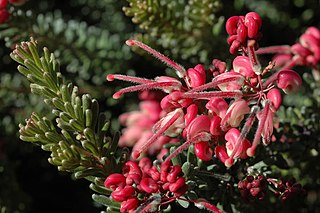
Grevillea lanigera, commonly known as woolly grevillea, is a species of flowering plant in the family Proteaceae and is endemic to south-eastern continental Australia. It is a spreading shrub with narrowly oblong to more or less linear leaves and clusters of pink to red, and cream-coloured flowers.

Grevillea sericea, commonly known as the pink spider flower, is a species of flowering plant in the family Proteaceae and is endemic to New South Wales. It is a shrub with elliptic to lance-shaped leaves with the narrower end towards the base, and clusters of usually pink flowers arranged on one side of a flowering rachis.
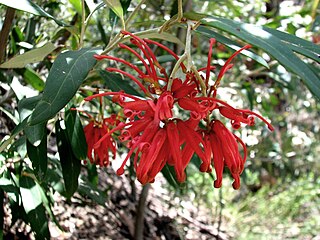
Grevillea victoriae, also known as royal grevillea or mountain grevillea, is a species of flowering plant in the family Proteaceae and is endemic to mountainous regions of south-eastern continental Australia. It is an erect to spreading shrub with elliptic to lance-shaped leaves, and pendulous clusters of red to orange flowers.
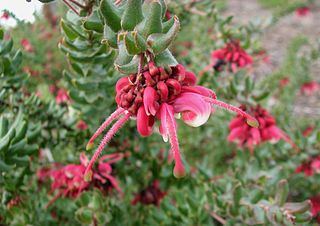
Grevillea baueri, commonly known as Bauer's grevillea, is a species of flowering plant in the family Proteaceae and is endemic to the coastal ranges of south-eastern New South Wales. It is a low, spreading to erect shrub with mostly oblong to egg-shaped leaves with red to pink and cream-coloured or yellow flowers.

Grevillea obtecta, commonly known as Fryerstown grevillea, Elphinstone grevillea or Taradale grevillea, is a species of flowering plant in the family Proteaceae and is endemic to Victoria in Australia. It is a prostrate, clumping or straggling shrub with pinnatifid, pinnatipartite or toothed leaves, and toothbrush-like clusters of light green to yellowish and purplish to black flowers with a dull yellow to pink style.
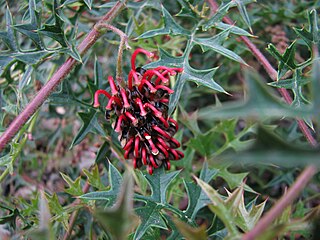
Grevillea montis-cole, commonly known as Mount Cole grevillea, is a species of flowering plant in the family Proteaceae and is endemic to central-western Victoria, Australia. It is a shrub with divided leaves with 5 to 15 lobes, the end lobes more or less triangular to narrowly oblong and sharply-pointed, and clusters of greenish to fawn and dull purplish flowers.

Grevillea gariwerdensis is a species of flowering plant in the family Proteaceae and is endemic to Grampians National Park in Victoria, Australia. It is a shrub with more or less linear to narrowly oblong leaves, and white to pink flowers with brownish hairs.
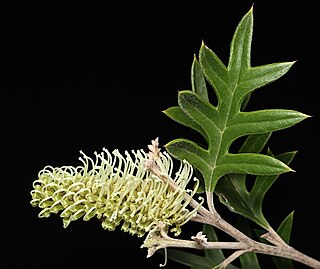
Grevillea willisii, commonly known as Omeo grevillea or rock grevillea, is species of flowering plant in the family Proteaceae, and is endemic to the eastern highlands of Victoria, Australia. It is a spreading to erect shrub with pinnatipartite leaves, the end lobes broadly triangular to oblong and sometimes sharply pointed, and dense clusters of greenish-white to fawn-coloured flowers with a white to cream-coloured style.

Grevillea confertifolia, commonly known as Grampians grevillea or dense-leaf grevillea, is a species of flowering plant in the family Proteaceae and is endemic to the Grampians in Victoria, Australia. It is a spreading, often dense shrub with linear to narrowly oblong leaves, and reddish-purple flowers.

Grevillea irrasa is a species of flowering plant in the family Proteaceae and is endemic to south-eastern New South Wales. It is an erect, spreading shrub with oblong to egg-shaped leaves with the narrower end towards the base, and clusters of red to apricot-coloured flowers.

Grevillea oxyantha is a species of flowering plant in the family Proteaceae and is endemic to south-eastern continental Australia. It is an erect to spreading shrub with somewhat silky-hairy branchlets, broadly elliptic to broadly egg-shaped or almost round leaves, and hairy, crimson and pink flowers with a red style.

Grevillea ilicifolia, commonly known as holly grevillea or holly bush, is a species of flowering plant in the family Proteaceae and is endemic to southern continental Australia. It is a spreading to prostrate shrub with holly-like leaves with sharply-pointed triangular to egg-shaped teeth or lobes, and clusters of green to cream-coloured and mauve flowers with a pink to red style.

Grevillea parvula , commonly known as Genoa grevillea, is a species of flowering plant in the family Proteaceae and is endemic to an area near the border between New South Wales and Victoria in south-eastern continental Australia. It is a spreading to erect shrub, usually with elliptic leaves, and down-turned clusters of pinkish to red flowers.
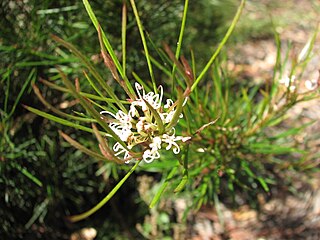
Grevillea neurophylla, commonly known as granite grevillea, is a species of flowering plant in the family Proteaceae and is endemic to south-eastern continental Australia. It is a spreading to erect shrub with linear leaves, and clusters of white to pale pink flowers with a strongly hooked style.

Grevillea patulifolia, commonly known as swamp grevillea, is a species of flowering plant in the family Proteaceae and is endemic to south-eastern continental Australia. It is an erect, or low spreading shrub with more or less linear to narrowly elliptic leaves, and large clusters of pale pink to dark mauve-pink flowers with a style that is hooked near its tip.
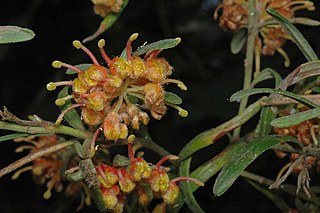
Grevillea polybractea, commonly known as crimson grevillea, is a species of flowering plant in the family Proteaceae and is endemic to the southeast of continental Australia. It is a spreading shrub with linear to narrowly oblong or narrowly elliptic leaves and pink to red and yellow or green flowers.
Grevillea obtusiflora is a species of flowering plant in the family Proteaceae and is endemic to a small area of eastern New South Wales. It is a low, spreading to erect shrub with many stems, narrowly elliptic to oblong or linear to narrowly egg-shaped leaves with the narrower end towards the base, and pinkish-red and cream-coloured flowers with a red style.

Grevillea ramosissima, commonly known as fan grevillea, is a species of flowering plant in the family Proteaceae and is endemic to eastern continental Australia. It is a low, spreading shrub with lobed leaves and clusters of cream-coloured to pale yellow flowers.

Grevillea humilis is a species of flowering plant in the family Proteaceae and is endemic to eastern New South Wales. It is an erect to spreading shrub with narrowly elliptic to more or less linear leaves, and pink or white flowers.




















